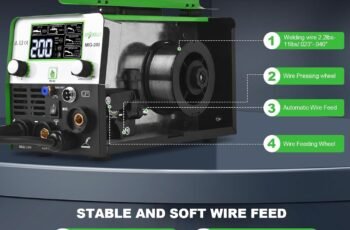Ad Blocker Detected
Our website is made possible by displaying online advertisements to our visitors. Please consider supporting us by disabling your ad blocker.
In MIG welding, voltage and amperage aren’t just numbers on a dial; they’re key to crafting strong, reliable welds. Voltage dictates the arc’s length and bead shape, while amperage controls penetration and deposition. Balancing these elements with wire feed speed is an art in itself. Curious about how these factors interconnect and impact your welding projects? There’s more to discover and fine-tune for that perfect weld.
Understanding Wire Size and Amperage Ranges
When you’re selecting wire size for MIG welding, understanding its relationship with amperage is crucial. You’ll find that each wire size has a specific amperage range, essential for effective welding. For thin sheets, 0.023-inch wire operates between 30-130 amps, whereas 0.035-inch wire suits heavier applications with a 50-180 amp range. Industrial tasks often need 0.045-inch wire at 75-250 amps. Overlapping amp ranges offer flexibility, so check manufacturer settings. Match wire size to material thickness: use 0.024″ wire for 24-gauge metals and larger wires like 0.035″-0.045″ for thicker materials. Thinner wires increase material transfer efficiency, while thicker wires provide necessary molten filler metal. Proper wire and amperage pairing ensures optimal penetration and robust welds. Incorrect settings can damage welds and equipment, making it crucial to adhere to guidelines for optimal results.
Constant Voltage Principles in MIG Welding
Though often overlooked, understanding constant voltage (CV) principles is essential for mastering MIG welding.
With CV systems, the voltage remains steady while the machine automatically adjusts the current to maintain a stable arc. This self-regulating feature ensures that variations in arc length, which alter resistance, don’t disrupt the welding process. The constant voltage sources allow for self-adjusting arc characteristics, which means that the system can adapt to changes without manual intervention.
When the arc length increases, resistance rises, causing the current to drop. Conversely, shortening the arc decreases resistance, boosting the current to maintain wire burn-off.
The CV mechanism enhances arc stability, reduces spatter, and improves metal transfer fluidity. By prioritizing voltage consistency, CV systems adapt to changes in joint conductivity and metal thickness, ensuring reliable weld quality.
You’ll find that CV welding is particularly effective for open-root joints and thicker materials.
The Influence of Wire Feed Speed on Amperage
Understanding the relationship between wire feed speed and amperage is crucial for effective MIG welding. When you increase the wire feed speed, the amperage rises directly to maintain arc stability. Your welding machine automatically adjusts the current to preserve the set voltage, ensuring consistent arc contact. The material thickness dictates the required amperage, with a general guideline of 1 amp per .001 inch, to ensure optimal performance. The stickout, or the distance from the contact tip to the arc, also affects amperage—shortening it increases the current. Different wire diameters require specific amperage ranges, such as 0.023″ needing 30-130A and 0.045″ requiring 75-250A.
Faster wire speeds improve conductivity, leading to stable current flow and deeper penetration. However, watch for excessive spatter and burn-through on thin materials due to high amperage, and adjust the travel speed to manage heat input properly.
Voltage’s Impact on Arc Characteristics
As you fine-tune the wire feed speed for optimal amperage, it’s equally important to focus on how voltage shapes the arc characteristics in MIG welding.
Higher voltage increases arc length, reducing electrode extension and wire resistance. This change can trigger spray transfer mode, transforming globular transfer into finer droplets. Increased voltage results in decreased electrode extension and increased current, ultimately affecting bead width and depth.
Voltage fluctuations impact nanoparticle formation, arc sound quality, and heat distribution through plasma flow patterns. Keep arc voltage within a 1-3V operational window for stable metal transfer, as variations lead to defects like excessive spatter or undercutting.
Achieving a flatter bead profile requires voltage levels that exceed base material penetration needs, widening the width-to-depth ratio. Proper voltage settings ensure consistent, high-quality welds without compromising fusion or bead shape.
Interconversions Between IPM and Amperage
When working with MIG welding machines, mastering the interconversion between IPM (Inches Per Minute) and amperage is crucial for achieving precise welds. You can convert IPM to amperage using wire-specific constants: for .035 wire, divide IPM by 1.6; for .030 wire, use 2; and for .045 wire, use 1. Material thickness often guides your starting amperage, like using 125 amps for 1/8-inch steel. It is crucial to achieve a proper balance between wire speed and voltage to produce strong, clean welds. Remember, higher IPM increases amperage, affecting heat and penetration. For .035 wire, 200 IPM typically equals 125 amps, achieving a balance between penetration and speed. Use a DC-sensitive amp clamp for accuracy. Real-world conditions can vary, so always test settings tailored to your specific material and wire type for optimal results.
Adjusting Voltage for Optimal Arc Shape
Voltage plays a pivotal role in shaping the arc during MIG welding, acting as the primary control mechanism for arc length. By adjusting voltage, you control the distance between the wire tip and the weld pool.
Higher voltage extends the arc, producing wider, flatter weld beads, while lower voltage shortens it, creating narrow, U-shaped beads ideal for thin materials.
Ensure voltage matches the wire type and thickness to maintain arc stability. Inadequate settings can lead to inconsistent arc ignition or wire burnback.
Voltage also influences bead formation and reinforcement height, crucial for structural integrity. When adjusting, follow manufacturer guidelines and monitor arc behavior—too high or too low can disrupt bead contours or fusion quality.
Amperage’s Role in Penetration and Deposition
Having adjusted voltage for the perfect arc shape, your next focus should be on amperage, the key driver for penetration and deposition in MIG welding.
Amperage directly dictates the depth of penetration. You control it primarily through wire feed speed (WFS) adjustments in constant-voltage machines.
Increasing WFS raises amperage, enhancing penetration but risking uneven welds if overdone.
Balance WFS with travel speed for optimal heat distribution, ensuring full fusion without excessive burn-through.
Selecting the Right Voltage for Material Thickness
As you approach the task of selecting the right voltage for material thickness, understanding the relationship between thickness and voltage levels is crucial.
For instance, mild steel at 0.5mm requires 15–17V, whereas 5.0mm needs 24–26V. Similarly, stainless steel demands adjusted voltages, such as 15–16.5V for 0.8mm and 19–20V for 4.75mm.
Thin materials, under 1.0mm, often necessitate reduced voltage (15–18V) to prevent burn-through. Auto-adjusting welders can be handy, offering preset voltage ranges based on thickness, and material-specific charts provide excellent starting points.
Don’t forget that shielding gas and wire feed speed also influence voltage settings. Conduct test welds to fine-tune your voltage for optimal results, especially for materials under 3/16″ (4.75mm).
The Relationship Between Voltage and Polarity
Understanding the appropriate voltage for material thickness lays the groundwork for mastering the interplay between voltage and polarity in MIG welding.
The standard DCEP polarity focuses 70% of arc energy into the wire, enhancing penetration and arc stability. This setup is ideal for most applications, offering effective heat distribution and consistent arc characteristics.
Voltage settings are crucial as they govern arc length and intensity, scaling with material thickness. Thicker materials demand higher voltages, while thinner ones need lower settings.
Voltage adjustments, even slight ones, can significantly impact weld quality. Ensuring your machine’s polarity matches the recommended settings for your wire and material enhances the fusion depth and minimizes defects, leveraging the full potential of your MIG setup.
Practical Tips for Voltage and Amperage Adjustments
When adjusting voltage and amperage in MIG welding, even slight tweaks can lead to significant improvements in weld quality.
Begin by matching amps to material thickness and wire size. Use 1 amp per 0.001″ of thickness, and know that 0.035″ wire operates best between 50–180 amps. For thick metals, increase amps beyond 180 to achieve full penetration.
Always observe arc behavior. A stable, bright arc signals balanced settings, while popping or hissing arcs require adjustments.
Adjust voltage inversely with wire speed to maintain a consistent current, and use charts as a baseline. Test on scrap metal to confirm settings, and analyze weld beads to ensure full fusion with minimal spatter.
Document successful settings for future use.
Conclusion
In MIG welding, mastering voltage and amperage settings is crucial for achieving high-quality welds. You need to understand how wire size and feed speed influence amperage, ensuring optimal penetration and deposition. Don’t overlook voltage’s role in determining arc characteristics and bead shape. Always select the right voltage for the material’s thickness and consider polarity’s impact. With these insights and practical tips, you’ll be well-equipped to make precise adjustments and enhance your welding outcomes.



